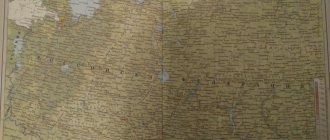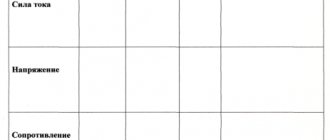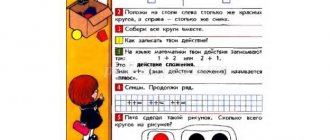Development of an open lesson in mathematics “Distributive law of multiplication” 5th grade.
Zhmurikova Natalya Anatolyevna, mathematics teacher MBOU Secondary School No. 18 Outline of an open mathematics lesson in 5th grade On the topic: “Distributive law of multiplication.” Lesson topic: Distributive law of multiplication. Lesson type: Lesson “Discovery of new knowledge” (lesson-study of new material) Purpose of the lesson: Establishing a new important connection between addition and multiplication of numbers when studying the topic “Distributive law of multiplication regarding addition and subtraction.” Planned results: - subject: perform calculations with natural numbers; be able to find the product of natural numbers; know and be able to apply the distributive law of multiplication to calculate the values of numerical expressions; write it down using letters. - meta-subject: cognitive UUD: the ability to choose the most effective ways to solve assigned problems, compare and analyze information, draw conclusions based on the information received; development of independent research skills; regulatory learning activities: the ability to organize the completion of tasks according to the teacher’s instructions, analyze the results of one’s work in the lesson, the ability to monitor and evaluate the process and results of activities; communicative learning skills: the ability to listen and engage in dialogue, participate in a collective discussion of problems, express and argue one’s point of view, the ability to answer questions, discuss issues with peers; personal learning achievements: the need for a fair assessment of one’s work and the work of classmates, the application of acquired knowledge in practical activities. Development of resourcefulness, activity in solving mathematical problems, the ability to emotionally perceive mathematical objects, problems, solutions, reasoning Form of the lesson: A lesson in the form of a dialogue leading to the topic, which is a system of questions and tasks that are feasible for students, which step by step lead students to the “discovery of new knowledge” " Questions and assignments vary in nature and degree of difficulty, but are feasible for students. Main functions of the lesson: 1.Creating problem situations and skillfully guiding students to solve them, organizing the search for a solution. 2. Inclusion of students in search and cognitive activities. 3. Students gain knowledge as a result of creative work, their understanding of the process of obtaining these results and the ability to independently solve the problem. As a result, there is a creative mastery of knowledge, abilities, skills and the development of thought processes, communicative actions, and cognitive activity. Technologies used: Developmental technologies, digital educational resources, cards.
Goal/objectives of the stage Teacher’s activities Student’s activities Competences/ aspects of competence/ AUD Assessment/ forms of control Result Stage I: motivation for learning activities - 2 min. Motivate students for learning activities in the lesson, determine the content of the lesson. Provides motivation, creates conditions for students to develop an internal need for inclusion in educational activities. Today I want to start the lesson with these words, which will be the motto of our lesson today: “Consider unhappy that day and that hour in which you did not learn anything new, did not add anything to your education.” Ya. A. Komensky Show interest in studying the material .
Explain how they understand this phrase Communication/dialogue. Self-control, verbal encouragement from the teacher. Internal and external readiness of students for learning activities in the classroom.
Stage II: updating and recording individual difficulties in a trial educational action - 5 min. Update learned methods of action, activate mental operations; fix difficulties. Organizes activities to update the recording of individual difficulties. 1. Solve the examples orally: 25+65+75 5?12?4 34+17+83 25?8?4 27+123+16+234 50(346?2) 76?5?2 Guys! Why did we solve such difficult examples so quickly? We write the formulas on the board. a+b=b+a ab=ba a(bc)=(ab)c a+(b+c)=(a+b)+c At home you learned the wording of the laws, check.
2. I suggest you also solve the examples orally: 1. 138•48+138•52= 2. 67•149+149•33= 3. 62•126+38•126= 4. 150•6= 5. 520•4 =
They update the methods of action, perform a trial educational action and record their own difficulty.
Answer questions Studied the commutative and associative laws of addition and multiplication These examples, at first glance, cannot be calculated orally. This means there is not enough knowledge to complete this task. A problematic situation arises.
Communicative (ability to construct a speech statement in accordance with the assigned tasks)
Educational-cognitive / use of information to solve educational problems. External control, self-control, mutual control Updating the learned methods of action; performing a trial educational action, recording difficulties. Stage III: Setting a learning task - 5 min. Discussion of difficulties
Why were there difficulties? What don't we know yet? Can we use existing formulas to complete the task? A problematic situation arises. They try to solve examples and express their opinions. They come to the conclusion that we do not yet know any law that will help us solve such examples orally.
Communicative / interaction Regulatory / ability to determine the purpose of activity in the lesson
Educational-cognitive / use of information to solve an educational problem, planning. Self-control, external control Readiness to perceive new knowledge Stage IV: Discovery of new knowledge (building a project for getting out of a difficulty) - 8 min. Organize communicative interaction to build a new method of action that eliminates the cause of the identified difficulty; fix a new way of action in a symbolic, verbal form. Work is organized in pairs. Each pair receives a problem that must be solved in different ways: (cardboard rectangles. Measure, find the area in two ways, derive a general formula). Let's move on to a discussion of the work we have done and its results. How many different methods did you consider? Let's discuss 1 way to solve the problem. Let us compare the obtained expressions using the 2nd method of solving the problem. What do they have in common? Compare the answers - the results of the problem when solved by the first and second methods. In such cases, the numerical value of the first expression is said to be equal to the numerical value of the second expression. What conclusion can be drawn from this fact? Right! Write down the corresponding equalities for the problem. Let's create a letter expression for the problem; to do this, we will replace different numbers with different letters. How many different letters do we need to write a letter expression? What can be written using a letter expression? So, perhaps, we also have some kind of law? How to read it? Try to translate it from mathematical language into Russian. This property was called the distributive property of multiplication relative to addition. Why do you think it was called distributive? Establish patterns; draw conclusions; formulate a rule (standard), record how to overcome a previously encountered difficulty.
process information.
They answer questions and discuss. We considered 2 solutions. We solved problems by composing an expression. In the problem in the first method, the expression contains brackets and two operations: addition and multiplication. In the second solution method, the expression contains three operations: two multiplication operations and one addition operation. The answers are the same. We can draw the following conclusion: in the problem, the first expression is equal to the second expression. Write down the resulting numerical equalities. Three different numbers, which means 3 letters are needed. (a+b)*c=ac+ab Property or rules.
To multiply a sum by a number, you can first multiply this number by the first term, then by the second term, and add the resulting products. Educational and cognitive/research activities.
Communicative/pair work, interaction
Information/information collection, processing and transmission. Self-control role.
Teacher's assessment of group work. Derive the Formula of the law and its verbal formulation. Then it is read according to the textbook Stage V: primary consolidation with commentary in external speech - 7 minutes. Organize children’s assimilation of a new method of action when solving problems with pronunciation in external speech. Organizes the work of students for the primary consolidation of students’ knowledge.
How can this law be useful to us? Will he help us verbally calculate the examples given at the beginning of the lesson? They carry out a commented letter with a pronunciation of methods of action. Complete the assignment in a notebook, working together with the class.
Educational-cognitive / use of information to solve an educational problem. Communicative/frontal work with a detailed explanation of the solution. 138*48+138*52=(48+52)*138=13800
67*149+149*33=(67+33)*149=14900
62*126+38*126=(62+38)*126=12600
150*6=(100+50)*6=600+300=6=900
520*4=(500+20)*4=2000+80=2080 External control, mutual control role. Mastering a new method of action when solving examples Fizminutka (musical). Stage VI: Incorporation of new knowledge into the knowledge system, repetition and control - 13 min. Organize independent completion of tasks for each student on a new way of action; organize self-testing by students of their decisions. Organizes the situation for solving a learning task; provides the opportunity to identify the causes of errors and eliminate them (individual correctional activities) 1. Solving tasks from the textbook. No. 219 (a-d) No. 222 (a, b) No. 223 (a, c) - What conclusion can be drawn? 2. Mathematical dictation. (presentation) Criteria: grade "5" - 5 tasks Grade "4" - 4 tasks Grade "3" - 3 tasks Grade "2" - less than 3 tasks. Students solve the proposed tasks, and problem situation No. 223 (a, c) arises. So this means that there is a distributive law regarding subtraction as well!
They exchange notebooks and give grades to their deskmate. Educational-cognitive / self-control and self-esteem
Information/processing, using information to solve a learning problem. Self-esteem. Determining the level of assimilation of a new way of acting
Stage VII: reflection on learning activities in the lesson. Lesson summary - 3 min. Organize reflection and self-assessment of students Organize reflection and self-assessment, explain homework. Questions: - What task was set in the lesson? — Did you manage to solve the problem? - How? — What results did you get? - What else needs to be done? — Where can you apply new knowledge? — What did you do well in the lesson? — What else needs to be worked on? Evaluate your work in class and your attitude to the new topic. Draw one of the suggested signs and a smiley face. (presentation) Announcement of grades for the lesson. Children correlate the goal of educational activity and its results, record the degree of compliance, assess the level of achievement of the goal and outline goals for further activities.
They answer the questions asked.
Conduct self-assessment. Educational-cognitive/self-esteem, mutual assessment. Information/processing and transmission of information. Self-control, mutual control, external control Students’ awareness of their learning activities; self-assessment of the results of one’s activities.
Stage VIII: information about homework – 2 min. Discuss and write down homework. Page 66 rule to remember, No. 219 (e - h), No. 223 (b, d) THANK YOU everyone for the lesson! They perceive information, write homework in diaries. Resources used: 1. Textbook I.I. Zubareva, A.G. Mordkovich "Mathematics". Ed. "Mnemosyne" M: 2010. 2. Internet resources https://school-collection.edu.ru https://school-collection.edu.ru/catalog/rubr/608887c4-68f4-410f-bbd4-618ad7929e22/113934/?interface=pupil&class=47&subject= 16
Independent work: “Properties of multiplication”
To prepare a concrete mixture, take 1 part cement, 4 parts sand and 3 parts water. How many kilograms of sand do you need to take to prepare 272 kg of concrete mixture?
Solving systems of equations using the substitution method The channel was created to help schoolchildren learn mathematics....
Lesson steps: 1. Checking homework. 2. “Warm-up” - test and mutual check. 3. “Mathematical relay race.” 4. Solving problems using equations. 5. Independent work and self-test. 6. Summing up the lesson. 7.
Presentation on the topic: “Lesson topic: “Distributive law of multiplication.” 5th grade. 1.".
Activate students' knowledge about the distributive law, expand and deepen knowledge on the topic. Create conditions so that students can apply them in practice when solving examples, equations and word problems. Develop a sustainable cognitive interest in the study of mathematics.
Stage No. 4. "Solving Problems Using Equations." 1 row. Masha, Olya and Tanya went into the forest to pick mushrooms. Masha collected 3 times more mushrooms than Tanya, and Olya collected 2 times more than Tanya. How many mushrooms did each girl collect if they collected 84 mushrooms in total? _________________________________________________________________ Row 2. Chameleons lived in the forest. Main functions of the lesson: 1.Creating problem situations and skillfully guiding students to solve them, organizing the search for a solution. 2. Inclusion of students in search and cognitive activities. 3. Students gain knowledge as a result of creative work, their understanding of the process of obtaining these results and the ability to independently solve the problem.
Solve the problem. Conditions Express through “x” forty is 2 times more than tits and 3 times less than bullfinches tits bullfinches In total, 18 birds were sitting on the tree.






